Investigating Workforce Diversity Management: McDonald's Teamwork
VerifiedAdded on 2019/09/22
|47
|15033
|274
Dissertation
AI Summary
This dissertation investigates the effect of managing workforce diversity through effective team working, using McDonald's as a case study. It examines the background of workforce diversity, its benefits, and challenges, alongside diversity management models and team working dynamics. The research explores the inter-relatedness of team diversity and workforce diversity, techniques and models for managing work teams, and suggests ways to manage diversity through effective teamwork. The methodology includes a research onion approach, mixed methods, and a survey to gather data. Data analysis covers gender, age, and role categories, team relationships, diversity among peer workers, and the impact of diversity on job performance. The dissertation concludes with recommendations on diversity management and team effectiveness within McDonald's, providing a critical evaluation of the study.
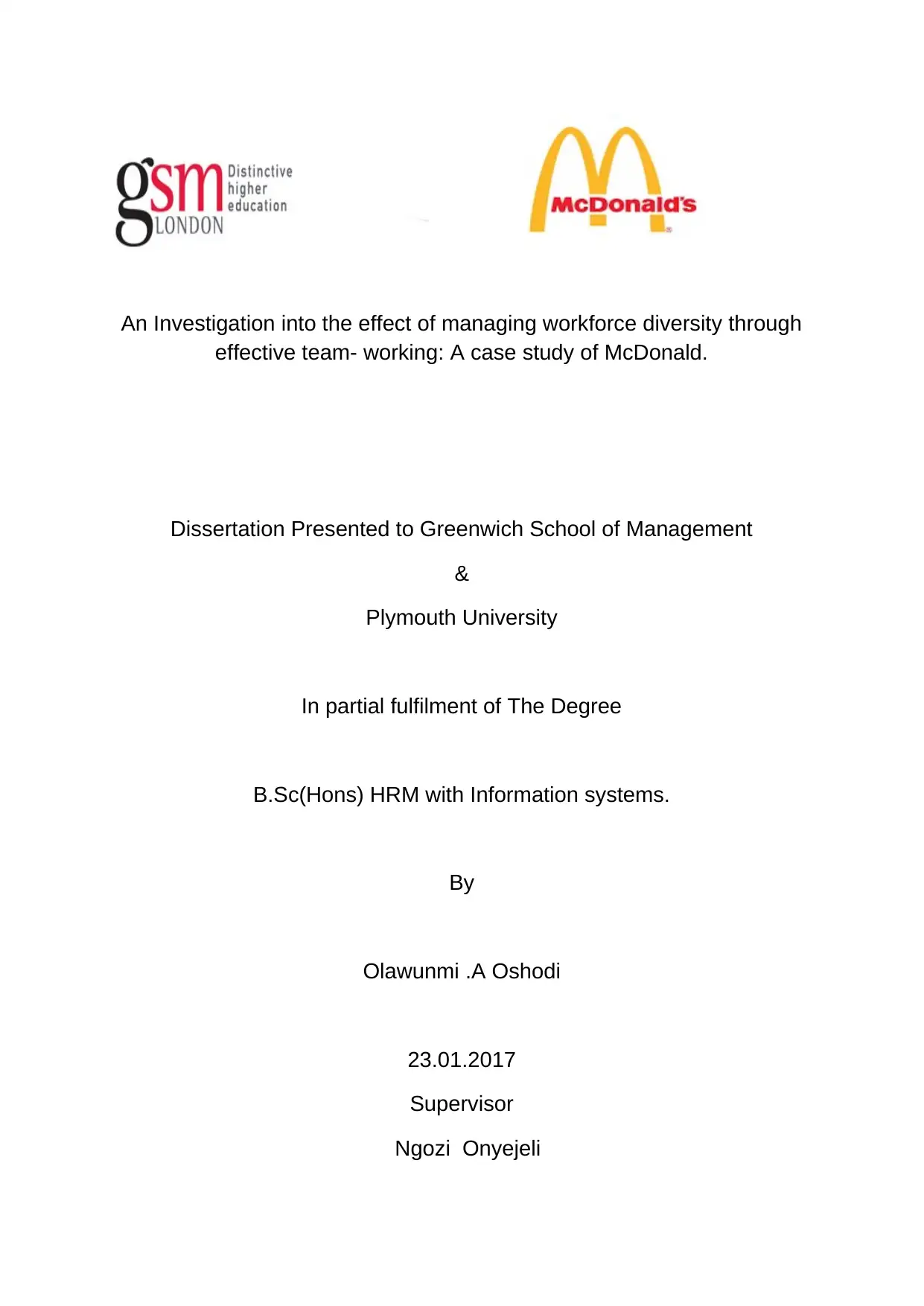
An Investigation into the effect of managing workforce diversity through
effective team- working: A case study of McDonald.
Dissertation Presented to Greenwich School of Management
&
Plymouth University
In partial fulfilment of The Degree
B.Sc(Hons) HRM with Information systems.
By
Olawunmi .A Oshodi
23.01.2017
Supervisor
Ngozi Onyejeli
effective team- working: A case study of McDonald.
Dissertation Presented to Greenwich School of Management
&
Plymouth University
In partial fulfilment of The Degree
B.Sc(Hons) HRM with Information systems.
By
Olawunmi .A Oshodi
23.01.2017
Supervisor
Ngozi Onyejeli
Paraphrase This Document
Need a fresh take? Get an instant paraphrase of this document with our AI Paraphraser
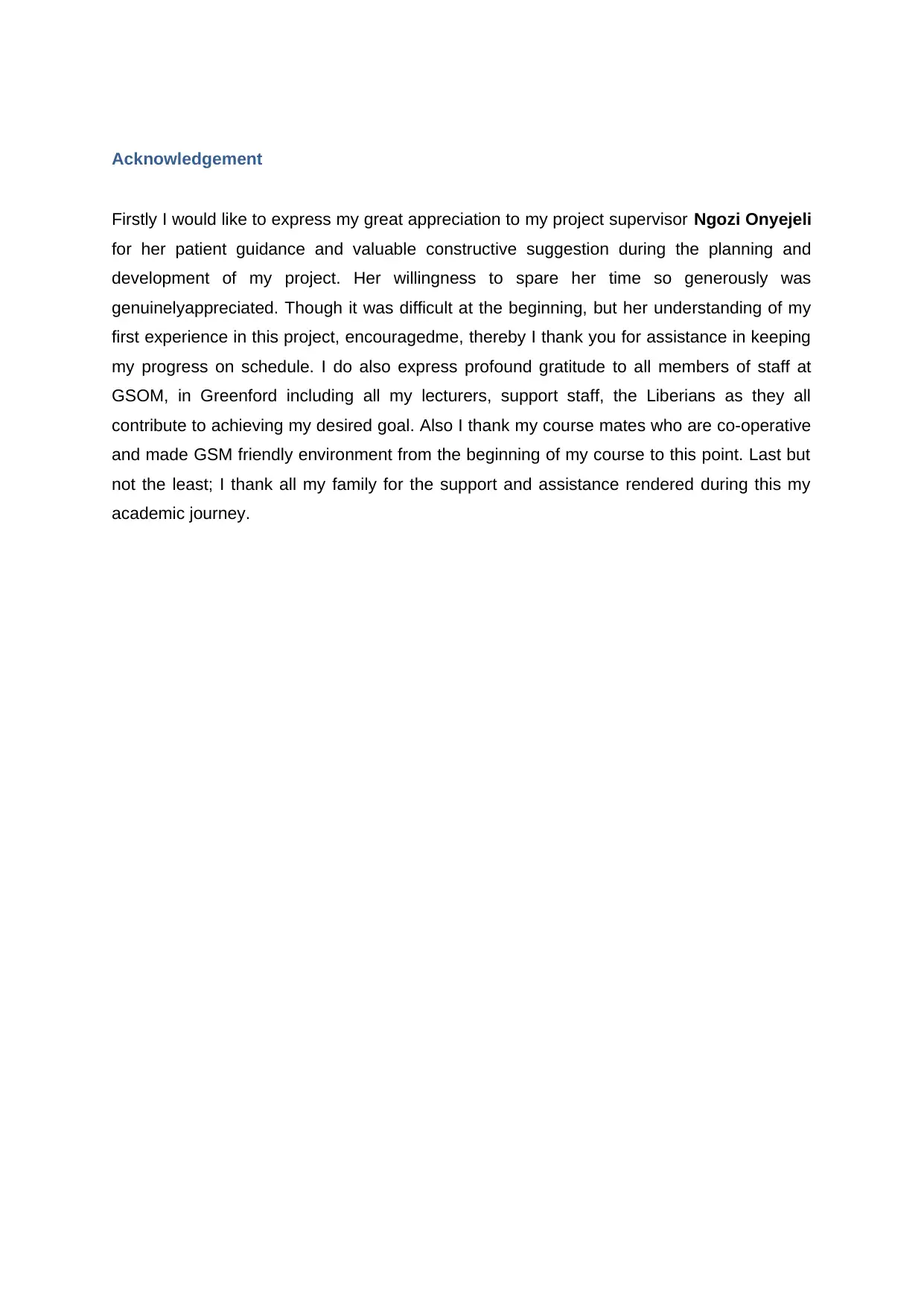
Acknowledgement
Firstly I would like to express my great appreciation to my project supervisor Ngozi Onyejeli
for her patient guidance and valuable constructive suggestion during the planning and
development of my project. Her willingness to spare her time so generously was
genuinelyappreciated. Though it was difficult at the beginning, but her understanding of my
first experience in this project, encouragedme, thereby I thank you for assistance in keeping
my progress on schedule. I do also express profound gratitude to all members of staff at
GSOM, in Greenford including all my lecturers, support staff, the Liberians as they all
contribute to achieving my desired goal. Also I thank my course mates who are co-operative
and made GSM friendly environment from the beginning of my course to this point. Last but
not the least; I thank all my family for the support and assistance rendered during this my
academic journey.
Firstly I would like to express my great appreciation to my project supervisor Ngozi Onyejeli
for her patient guidance and valuable constructive suggestion during the planning and
development of my project. Her willingness to spare her time so generously was
genuinelyappreciated. Though it was difficult at the beginning, but her understanding of my
first experience in this project, encouragedme, thereby I thank you for assistance in keeping
my progress on schedule. I do also express profound gratitude to all members of staff at
GSOM, in Greenford including all my lecturers, support staff, the Liberians as they all
contribute to achieving my desired goal. Also I thank my course mates who are co-operative
and made GSM friendly environment from the beginning of my course to this point. Last but
not the least; I thank all my family for the support and assistance rendered during this my
academic journey.
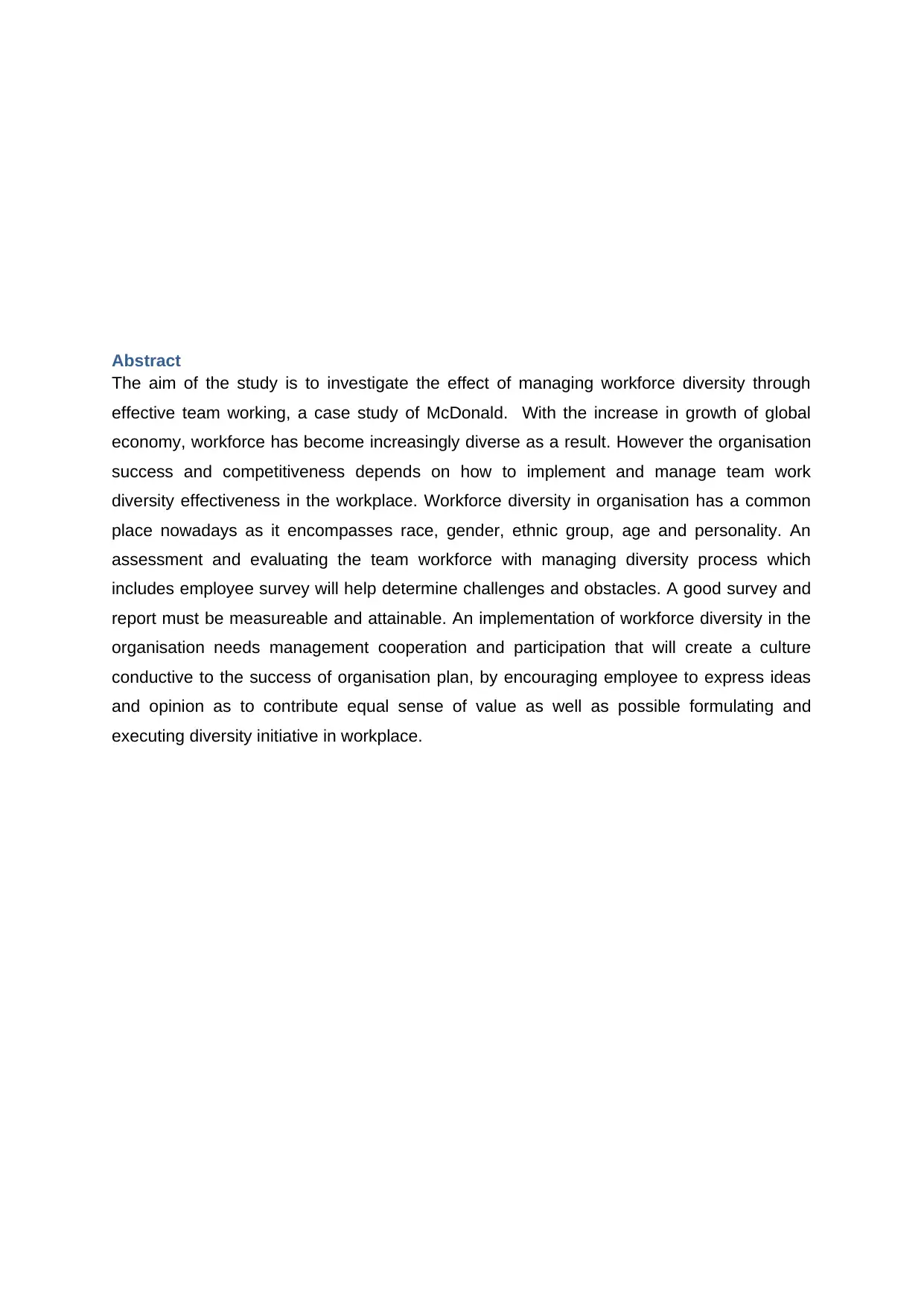
Abstract
The aim of the study is to investigate the effect of managing workforce diversity through
effective team working, a case study of McDonald. With the increase in growth of global
economy, workforce has become increasingly diverse as a result. However the organisation
success and competitiveness depends on how to implement and manage team work
diversity effectiveness in the workplace. Workforce diversity in organisation has a common
place nowadays as it encompasses race, gender, ethnic group, age and personality. An
assessment and evaluating the team workforce with managing diversity process which
includes employee survey will help determine challenges and obstacles. A good survey and
report must be measureable and attainable. An implementation of workforce diversity in the
organisation needs management cooperation and participation that will create a culture
conductive to the success of organisation plan, by encouraging employee to express ideas
and opinion as to contribute equal sense of value as well as possible formulating and
executing diversity initiative in workplace.
The aim of the study is to investigate the effect of managing workforce diversity through
effective team working, a case study of McDonald. With the increase in growth of global
economy, workforce has become increasingly diverse as a result. However the organisation
success and competitiveness depends on how to implement and manage team work
diversity effectiveness in the workplace. Workforce diversity in organisation has a common
place nowadays as it encompasses race, gender, ethnic group, age and personality. An
assessment and evaluating the team workforce with managing diversity process which
includes employee survey will help determine challenges and obstacles. A good survey and
report must be measureable and attainable. An implementation of workforce diversity in the
organisation needs management cooperation and participation that will create a culture
conductive to the success of organisation plan, by encouraging employee to express ideas
and opinion as to contribute equal sense of value as well as possible formulating and
executing diversity initiative in workplace.
⊘ This is a preview!⊘
Do you want full access?
Subscribe today to unlock all pages.

Trusted by 1+ million students worldwide
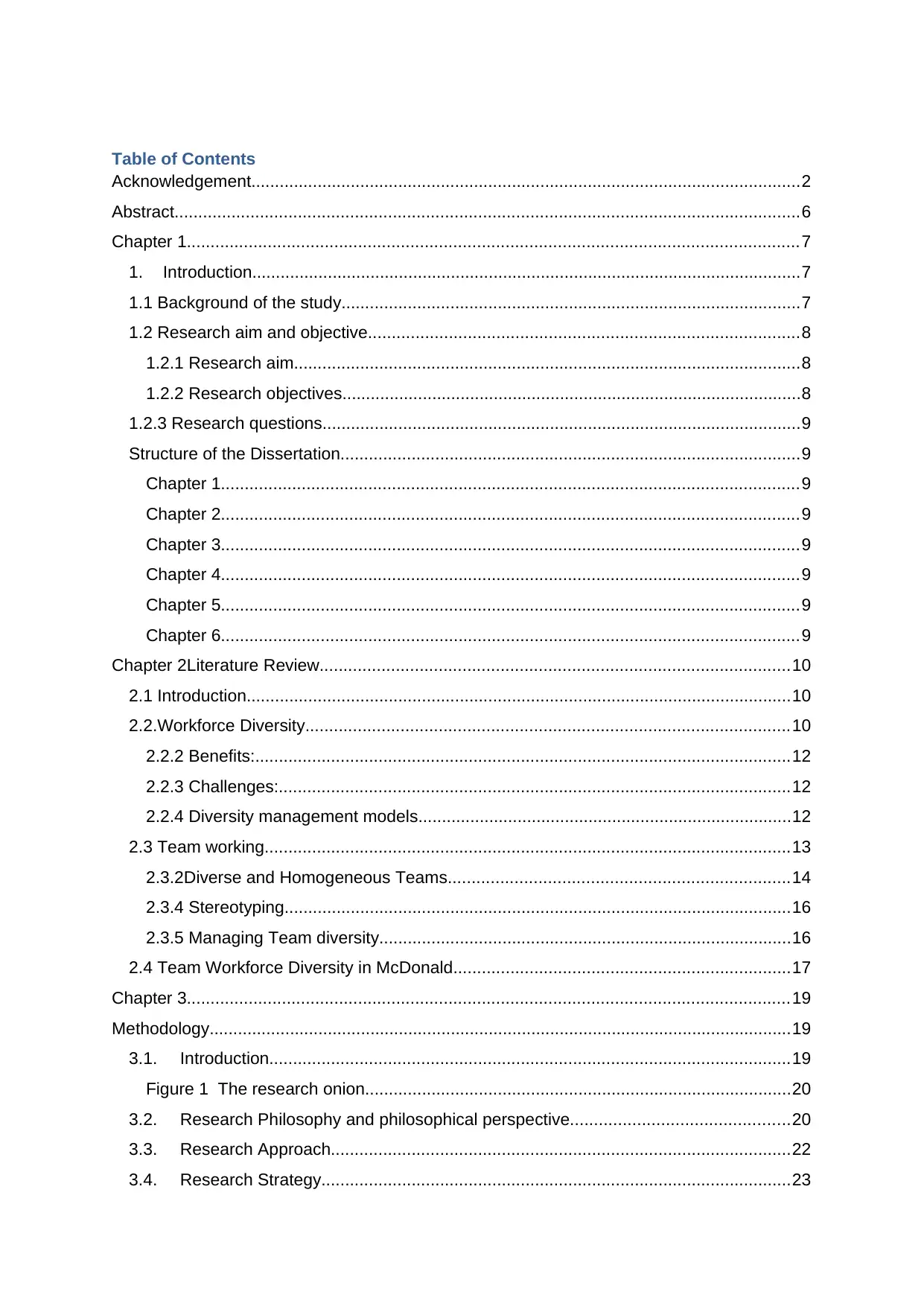
Table of Contents
Acknowledgement....................................................................................................................2
Abstract....................................................................................................................................6
Chapter 1.................................................................................................................................7
1. Introduction....................................................................................................................7
1.1 Background of the study.................................................................................................7
1.2 Research aim and objective...........................................................................................8
1.2.1 Research aim...........................................................................................................8
1.2.2 Research objectives.................................................................................................8
1.2.3 Research questions.....................................................................................................9
Structure of the Dissertation.................................................................................................9
Chapter 1..........................................................................................................................9
Chapter 2..........................................................................................................................9
Chapter 3..........................................................................................................................9
Chapter 4..........................................................................................................................9
Chapter 5..........................................................................................................................9
Chapter 6..........................................................................................................................9
Chapter 2Literature Review...................................................................................................10
2.1 Introduction...................................................................................................................10
2.2.Workforce Diversity......................................................................................................10
2.2.2 Benefits:.................................................................................................................12
2.2.3 Challenges:............................................................................................................12
2.2.4 Diversity management models...............................................................................12
2.3 Team working...............................................................................................................13
2.3.2Diverse and Homogeneous Teams........................................................................14
2.3.4 Stereotyping...........................................................................................................16
2.3.5 Managing Team diversity.......................................................................................16
2.4 Team Workforce Diversity in McDonald.......................................................................17
Chapter 3...............................................................................................................................19
Methodology...........................................................................................................................19
3.1. Introduction..............................................................................................................19
Figure 1 The research onion..........................................................................................20
3.2. Research Philosophy and philosophical perspective..............................................20
3.3. Research Approach.................................................................................................22
3.4. Research Strategy...................................................................................................23
Acknowledgement....................................................................................................................2
Abstract....................................................................................................................................6
Chapter 1.................................................................................................................................7
1. Introduction....................................................................................................................7
1.1 Background of the study.................................................................................................7
1.2 Research aim and objective...........................................................................................8
1.2.1 Research aim...........................................................................................................8
1.2.2 Research objectives.................................................................................................8
1.2.3 Research questions.....................................................................................................9
Structure of the Dissertation.................................................................................................9
Chapter 1..........................................................................................................................9
Chapter 2..........................................................................................................................9
Chapter 3..........................................................................................................................9
Chapter 4..........................................................................................................................9
Chapter 5..........................................................................................................................9
Chapter 6..........................................................................................................................9
Chapter 2Literature Review...................................................................................................10
2.1 Introduction...................................................................................................................10
2.2.Workforce Diversity......................................................................................................10
2.2.2 Benefits:.................................................................................................................12
2.2.3 Challenges:............................................................................................................12
2.2.4 Diversity management models...............................................................................12
2.3 Team working...............................................................................................................13
2.3.2Diverse and Homogeneous Teams........................................................................14
2.3.4 Stereotyping...........................................................................................................16
2.3.5 Managing Team diversity.......................................................................................16
2.4 Team Workforce Diversity in McDonald.......................................................................17
Chapter 3...............................................................................................................................19
Methodology...........................................................................................................................19
3.1. Introduction..............................................................................................................19
Figure 1 The research onion..........................................................................................20
3.2. Research Philosophy and philosophical perspective..............................................20
3.3. Research Approach.................................................................................................22
3.4. Research Strategy...................................................................................................23
Paraphrase This Document
Need a fresh take? Get an instant paraphrase of this document with our AI Paraphraser
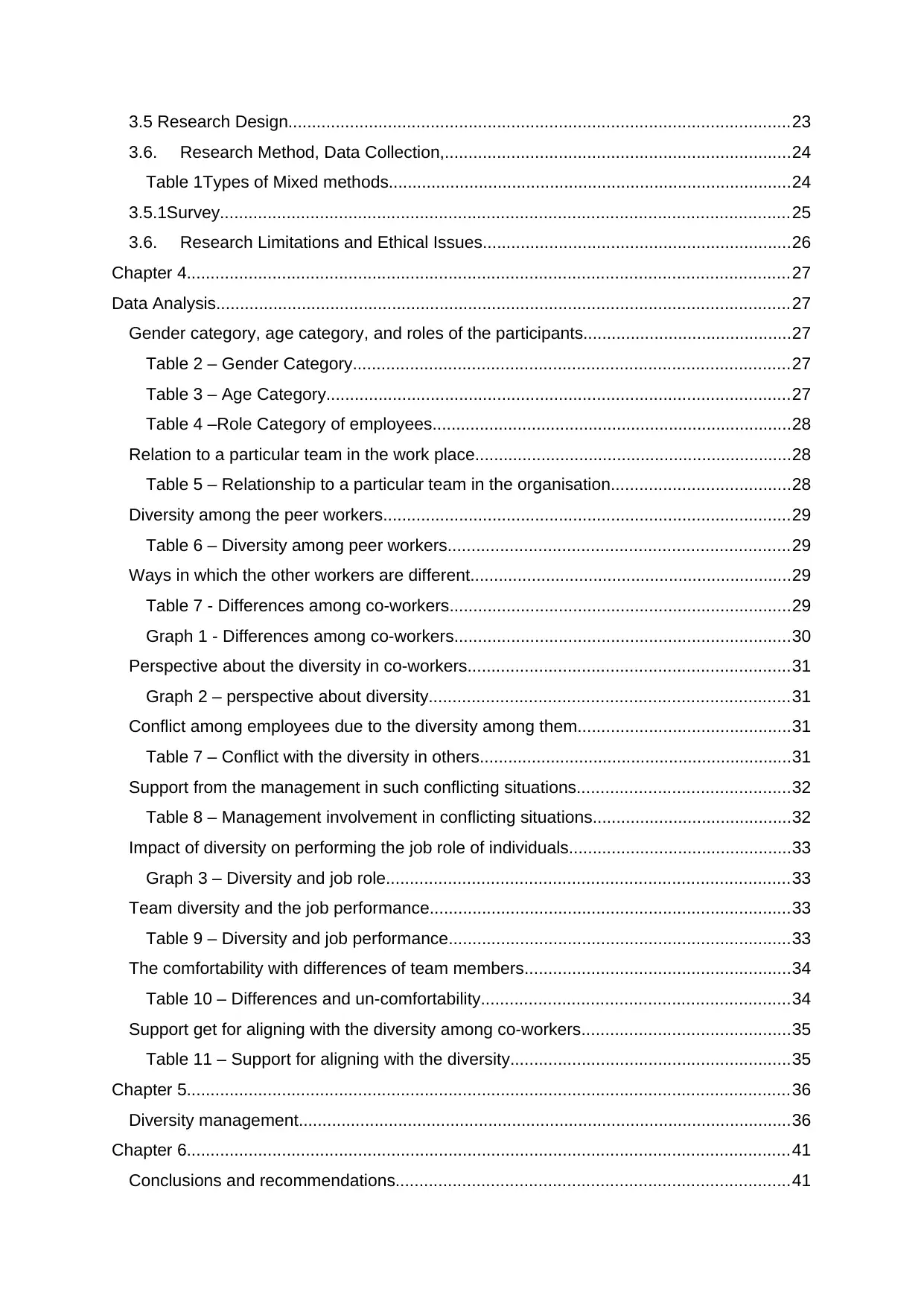
3.5 Research Design..........................................................................................................23
3.6. Research Method, Data Collection,.........................................................................24
Table 1Types of Mixed methods.....................................................................................24
3.5.1Survey........................................................................................................................25
3.6. Research Limitations and Ethical Issues.................................................................26
Chapter 4...............................................................................................................................27
Data Analysis.........................................................................................................................27
Gender category, age category, and roles of the participants............................................27
Table 2 – Gender Category............................................................................................27
Table 3 – Age Category..................................................................................................27
Table 4 –Role Category of employees............................................................................28
Relation to a particular team in the work place...................................................................28
Table 5 – Relationship to a particular team in the organisation......................................28
Diversity among the peer workers......................................................................................29
Table 6 – Diversity among peer workers........................................................................29
Ways in which the other workers are different....................................................................29
Table 7 - Differences among co-workers........................................................................29
Graph 1 - Differences among co-workers.......................................................................30
Perspective about the diversity in co-workers....................................................................31
Graph 2 – perspective about diversity............................................................................31
Conflict among employees due to the diversity among them.............................................31
Table 7 – Conflict with the diversity in others..................................................................31
Support from the management in such conflicting situations.............................................32
Table 8 – Management involvement in conflicting situations..........................................32
Impact of diversity on performing the job role of individuals...............................................33
Graph 3 – Diversity and job role.....................................................................................33
Team diversity and the job performance............................................................................33
Table 9 – Diversity and job performance........................................................................33
The comfortability with differences of team members........................................................34
Table 10 – Differences and un-comfortability.................................................................34
Support get for aligning with the diversity among co-workers............................................35
Table 11 – Support for aligning with the diversity...........................................................35
Chapter 5...............................................................................................................................36
Diversity management........................................................................................................36
Chapter 6...............................................................................................................................41
Conclusions and recommendations...................................................................................41
3.6. Research Method, Data Collection,.........................................................................24
Table 1Types of Mixed methods.....................................................................................24
3.5.1Survey........................................................................................................................25
3.6. Research Limitations and Ethical Issues.................................................................26
Chapter 4...............................................................................................................................27
Data Analysis.........................................................................................................................27
Gender category, age category, and roles of the participants............................................27
Table 2 – Gender Category............................................................................................27
Table 3 – Age Category..................................................................................................27
Table 4 –Role Category of employees............................................................................28
Relation to a particular team in the work place...................................................................28
Table 5 – Relationship to a particular team in the organisation......................................28
Diversity among the peer workers......................................................................................29
Table 6 – Diversity among peer workers........................................................................29
Ways in which the other workers are different....................................................................29
Table 7 - Differences among co-workers........................................................................29
Graph 1 - Differences among co-workers.......................................................................30
Perspective about the diversity in co-workers....................................................................31
Graph 2 – perspective about diversity............................................................................31
Conflict among employees due to the diversity among them.............................................31
Table 7 – Conflict with the diversity in others..................................................................31
Support from the management in such conflicting situations.............................................32
Table 8 – Management involvement in conflicting situations..........................................32
Impact of diversity on performing the job role of individuals...............................................33
Graph 3 – Diversity and job role.....................................................................................33
Team diversity and the job performance............................................................................33
Table 9 – Diversity and job performance........................................................................33
The comfortability with differences of team members........................................................34
Table 10 – Differences and un-comfortability.................................................................34
Support get for aligning with the diversity among co-workers............................................35
Table 11 – Support for aligning with the diversity...........................................................35
Chapter 5...............................................................................................................................36
Diversity management........................................................................................................36
Chapter 6...............................................................................................................................41
Conclusions and recommendations...................................................................................41
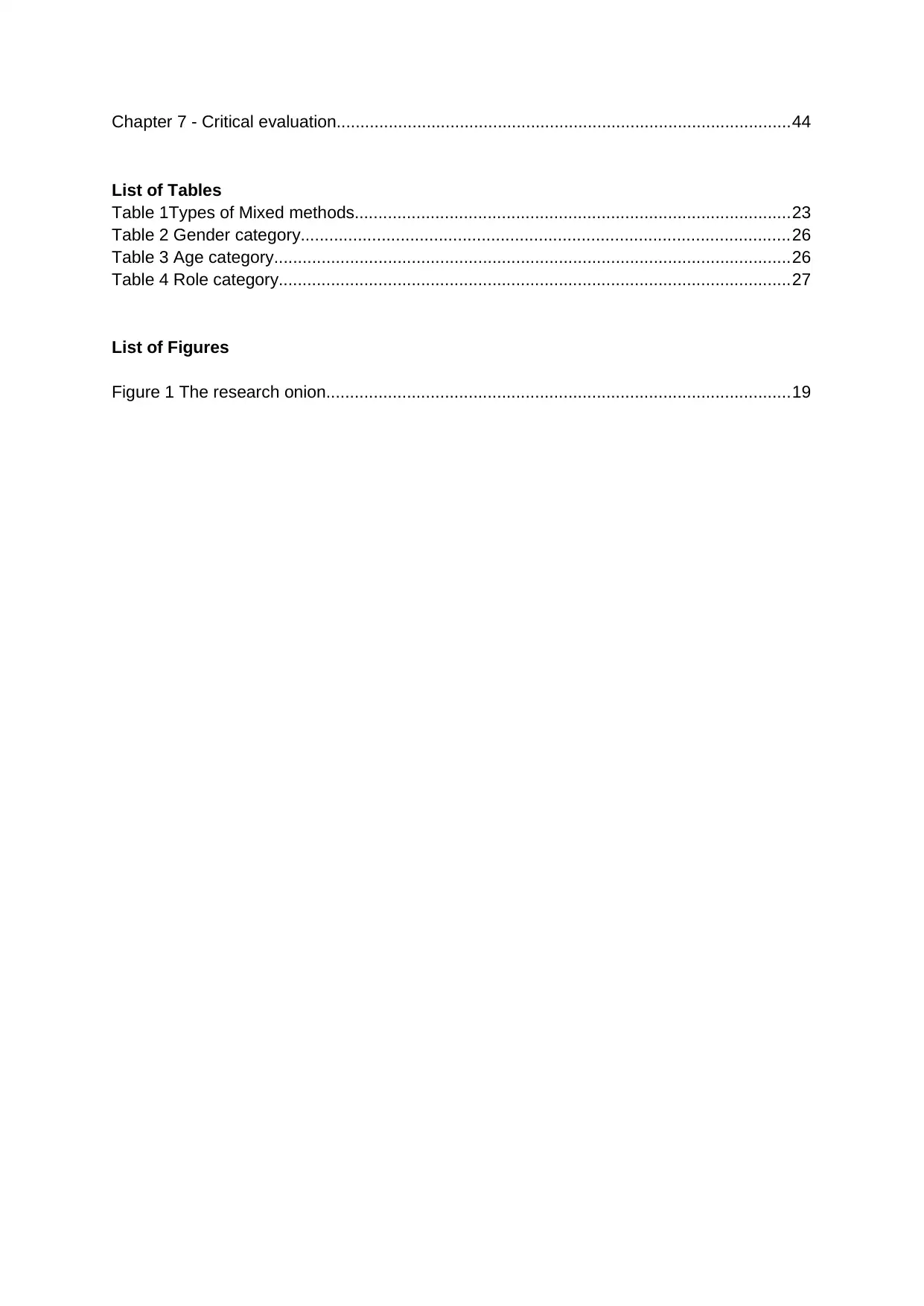
Chapter 7 - Critical evaluation................................................................................................44
List of Tables
Table 1Types of Mixed methods............................................................................................23
Table 2 Gender category.......................................................................................................26
Table 3 Age category.............................................................................................................26
Table 4 Role category............................................................................................................27
List of Figures
Figure 1 The research onion..................................................................................................19
List of Tables
Table 1Types of Mixed methods............................................................................................23
Table 2 Gender category.......................................................................................................26
Table 3 Age category.............................................................................................................26
Table 4 Role category............................................................................................................27
List of Figures
Figure 1 The research onion..................................................................................................19
⊘ This is a preview!⊘
Do you want full access?
Subscribe today to unlock all pages.

Trusted by 1+ million students worldwide
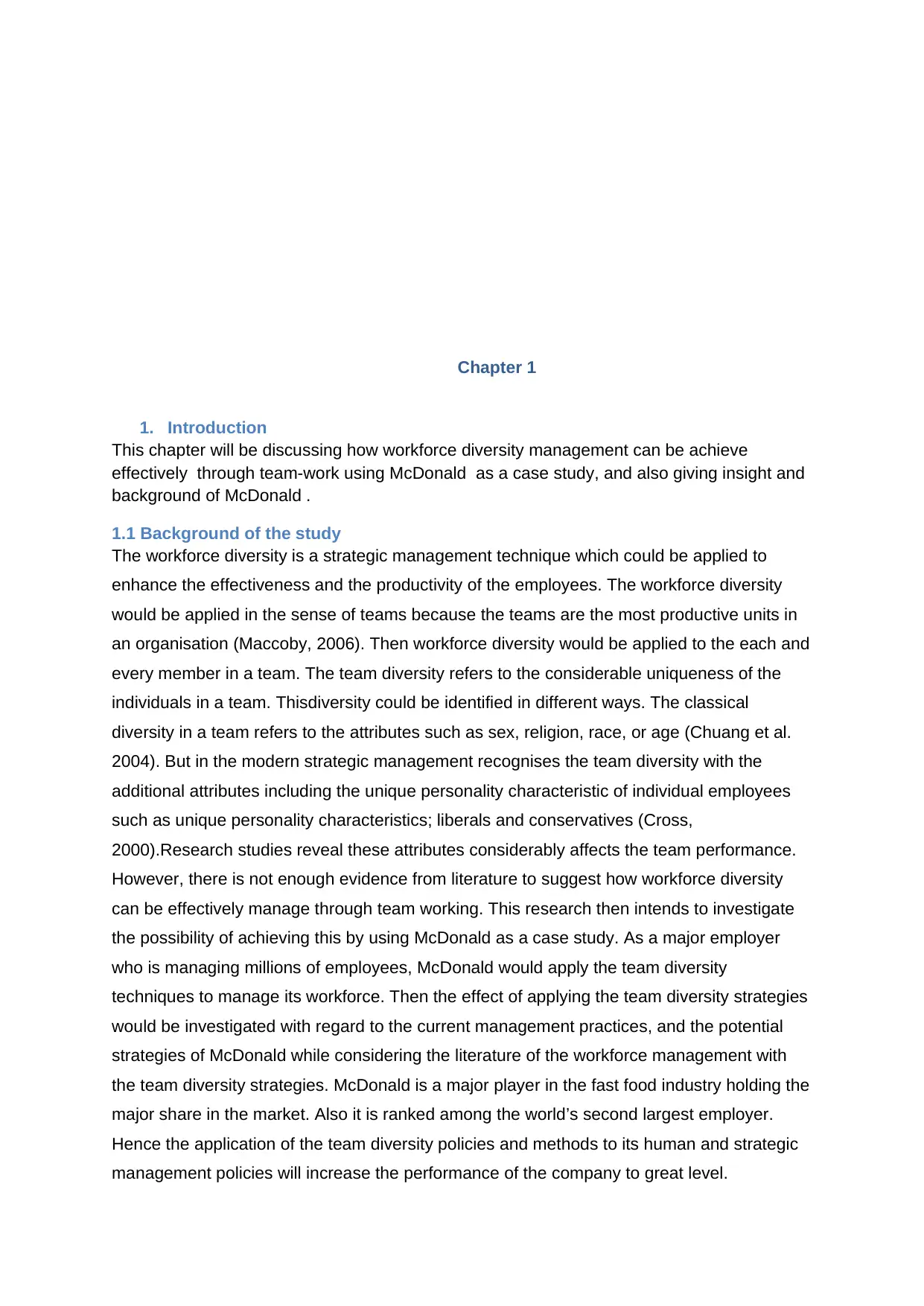
Chapter 1
1. Introduction
This chapter will be discussing how workforce diversity management can be achieve
effectively through team-work using McDonald as a case study, and also giving insight and
background of McDonald .
1.1 Background of the study
The workforce diversity is a strategic management technique which could be applied to
enhance the effectiveness and the productivity of the employees. The workforce diversity
would be applied in the sense of teams because the teams are the most productive units in
an organisation (Maccoby, 2006). Then workforce diversity would be applied to the each and
every member in a team. The team diversity refers to the considerable uniqueness of the
individuals in a team. Thisdiversity could be identified in different ways. The classical
diversity in a team refers to the attributes such as sex, religion, race, or age (Chuang et al.
2004). But in the modern strategic management recognises the team diversity with the
additional attributes including the unique personality characteristic of individual employees
such as unique personality characteristics; liberals and conservatives (Cross,
2000).Research studies reveal these attributes considerably affects the team performance.
However, there is not enough evidence from literature to suggest how workforce diversity
can be effectively manage through team working. This research then intends to investigate
the possibility of achieving this by using McDonald as a case study. As a major employer
who is managing millions of employees, McDonald would apply the team diversity
techniques to manage its workforce. Then the effect of applying the team diversity strategies
would be investigated with regard to the current management practices, and the potential
strategies of McDonald while considering the literature of the workforce management with
the team diversity strategies. McDonald is a major player in the fast food industry holding the
major share in the market. Also it is ranked among the world’s second largest employer.
Hence the application of the team diversity policies and methods to its human and strategic
management policies will increase the performance of the company to great level.
1. Introduction
This chapter will be discussing how workforce diversity management can be achieve
effectively through team-work using McDonald as a case study, and also giving insight and
background of McDonald .
1.1 Background of the study
The workforce diversity is a strategic management technique which could be applied to
enhance the effectiveness and the productivity of the employees. The workforce diversity
would be applied in the sense of teams because the teams are the most productive units in
an organisation (Maccoby, 2006). Then workforce diversity would be applied to the each and
every member in a team. The team diversity refers to the considerable uniqueness of the
individuals in a team. Thisdiversity could be identified in different ways. The classical
diversity in a team refers to the attributes such as sex, religion, race, or age (Chuang et al.
2004). But in the modern strategic management recognises the team diversity with the
additional attributes including the unique personality characteristic of individual employees
such as unique personality characteristics; liberals and conservatives (Cross,
2000).Research studies reveal these attributes considerably affects the team performance.
However, there is not enough evidence from literature to suggest how workforce diversity
can be effectively manage through team working. This research then intends to investigate
the possibility of achieving this by using McDonald as a case study. As a major employer
who is managing millions of employees, McDonald would apply the team diversity
techniques to manage its workforce. Then the effect of applying the team diversity strategies
would be investigated with regard to the current management practices, and the potential
strategies of McDonald while considering the literature of the workforce management with
the team diversity strategies. McDonald is a major player in the fast food industry holding the
major share in the market. Also it is ranked among the world’s second largest employer.
Hence the application of the team diversity policies and methods to its human and strategic
management policies will increase the performance of the company to great level.
Paraphrase This Document
Need a fresh take? Get an instant paraphrase of this document with our AI Paraphraser
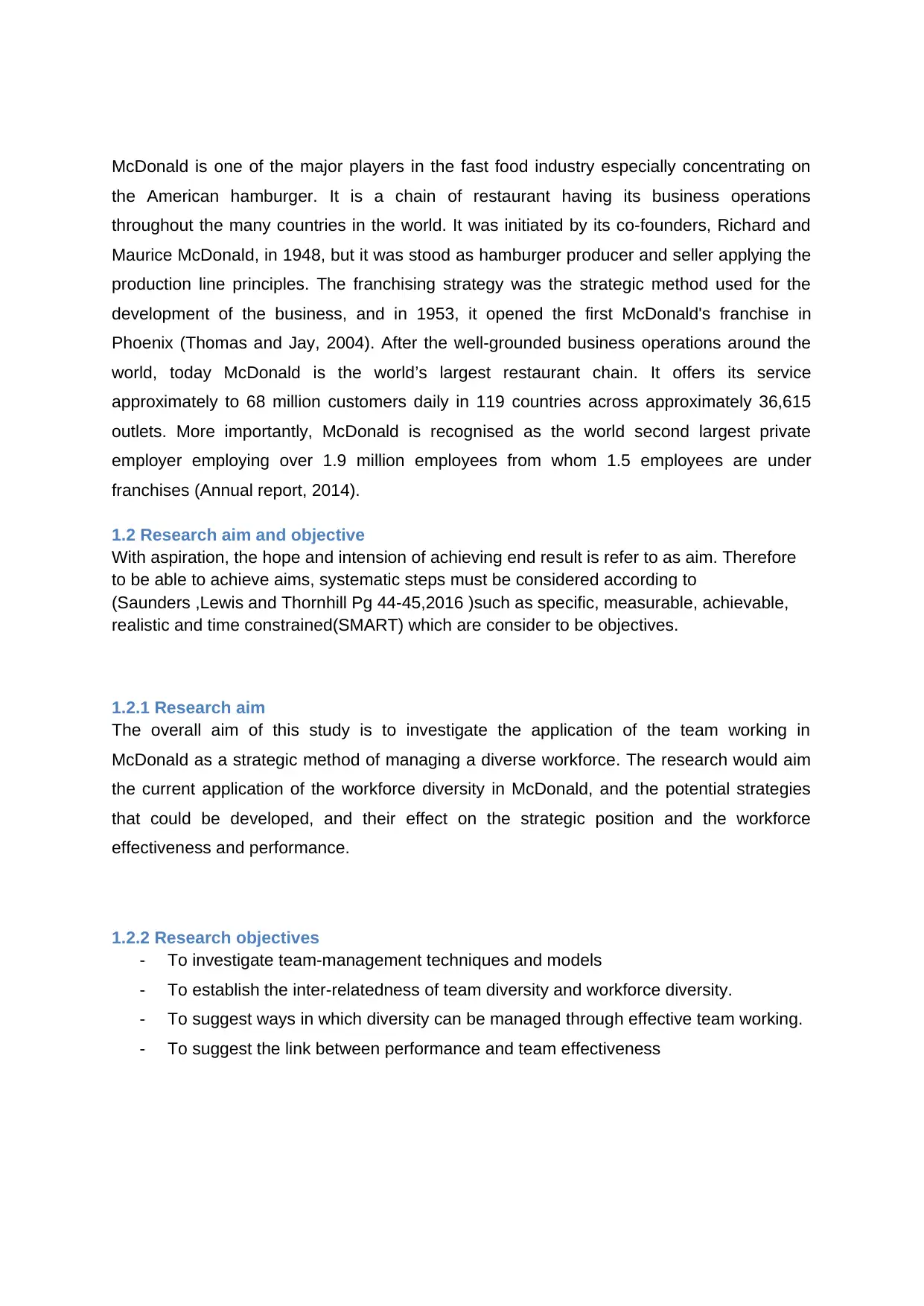
McDonald is one of the major players in the fast food industry especially concentrating on
the American hamburger. It is a chain of restaurant having its business operations
throughout the many countries in the world. It was initiated by its co-founders, Richard and
Maurice McDonald, in 1948, but it was stood as hamburger producer and seller applying the
production line principles. The franchising strategy was the strategic method used for the
development of the business, and in 1953, it opened the first McDonald's franchise in
Phoenix (Thomas and Jay, 2004). After the well-grounded business operations around the
world, today McDonald is the world’s largest restaurant chain. It offers its service
approximately to 68 million customers daily in 119 countries across approximately 36,615
outlets. More importantly, McDonald is recognised as the world second largest private
employer employing over 1.9 million employees from whom 1.5 employees are under
franchises (Annual report, 2014).
1.2 Research aim and objective
With aspiration, the hope and intension of achieving end result is refer to as aim. Therefore
to be able to achieve aims, systematic steps must be considered according to
(Saunders ,Lewis and Thornhill Pg 44-45,2016 )such as specific, measurable, achievable,
realistic and time constrained(SMART) which are consider to be objectives.
1.2.1 Research aim
The overall aim of this study is to investigate the application of the team working in
McDonald as a strategic method of managing a diverse workforce. The research would aim
the current application of the workforce diversity in McDonald, and the potential strategies
that could be developed, and their effect on the strategic position and the workforce
effectiveness and performance.
1.2.2 Research objectives
- To investigate team-management techniques and models
- To establish the inter-relatedness of team diversity and workforce diversity.
- To suggest ways in which diversity can be managed through effective team working.
- To suggest the link between performance and team effectiveness
the American hamburger. It is a chain of restaurant having its business operations
throughout the many countries in the world. It was initiated by its co-founders, Richard and
Maurice McDonald, in 1948, but it was stood as hamburger producer and seller applying the
production line principles. The franchising strategy was the strategic method used for the
development of the business, and in 1953, it opened the first McDonald's franchise in
Phoenix (Thomas and Jay, 2004). After the well-grounded business operations around the
world, today McDonald is the world’s largest restaurant chain. It offers its service
approximately to 68 million customers daily in 119 countries across approximately 36,615
outlets. More importantly, McDonald is recognised as the world second largest private
employer employing over 1.9 million employees from whom 1.5 employees are under
franchises (Annual report, 2014).
1.2 Research aim and objective
With aspiration, the hope and intension of achieving end result is refer to as aim. Therefore
to be able to achieve aims, systematic steps must be considered according to
(Saunders ,Lewis and Thornhill Pg 44-45,2016 )such as specific, measurable, achievable,
realistic and time constrained(SMART) which are consider to be objectives.
1.2.1 Research aim
The overall aim of this study is to investigate the application of the team working in
McDonald as a strategic method of managing a diverse workforce. The research would aim
the current application of the workforce diversity in McDonald, and the potential strategies
that could be developed, and their effect on the strategic position and the workforce
effectiveness and performance.
1.2.2 Research objectives
- To investigate team-management techniques and models
- To establish the inter-relatedness of team diversity and workforce diversity.
- To suggest ways in which diversity can be managed through effective team working.
- To suggest the link between performance and team effectiveness
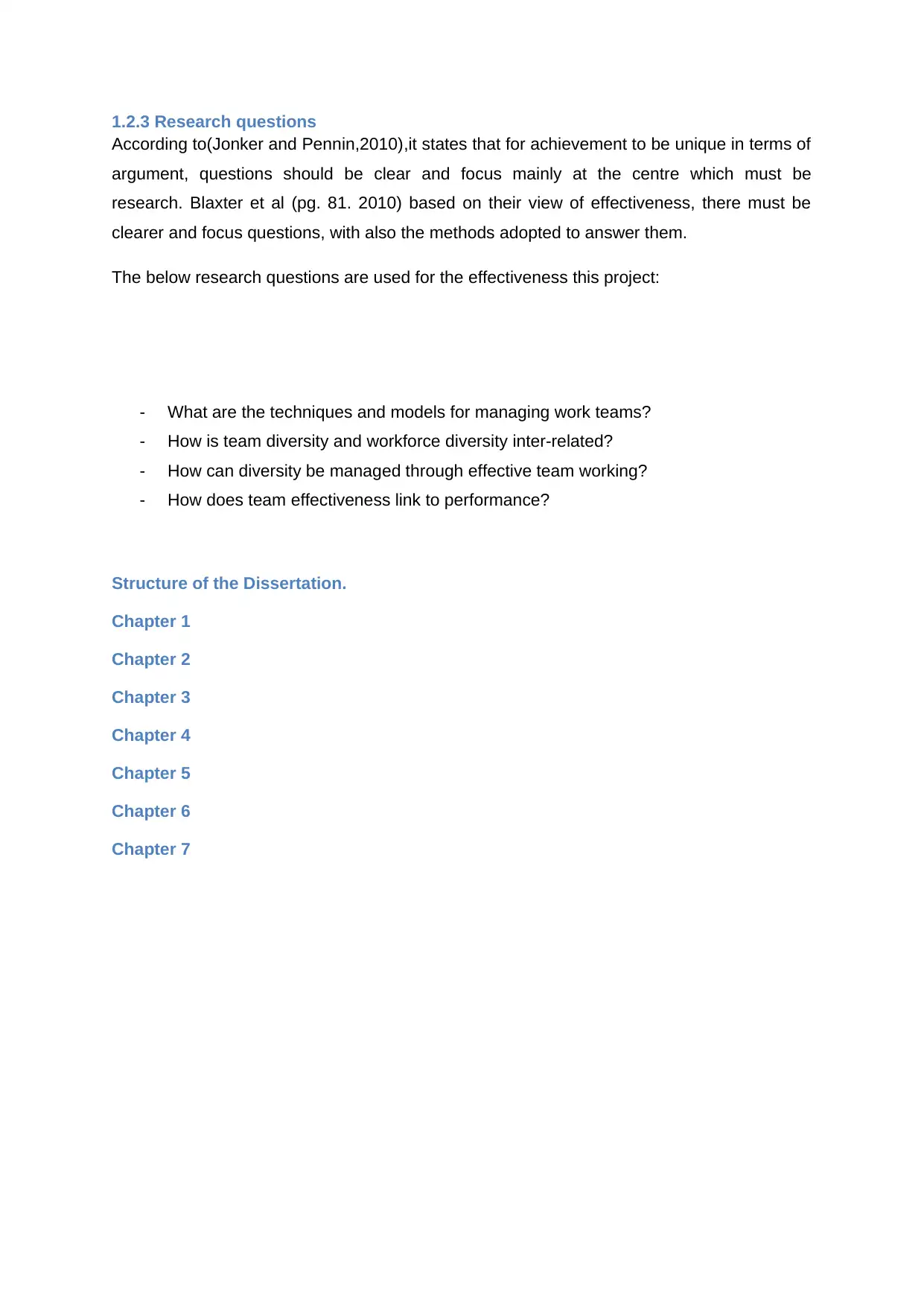
1.2.3 Research questions
According to(Jonker and Pennin,2010),it states that for achievement to be unique in terms of
argument, questions should be clear and focus mainly at the centre which must be
research. Blaxter et al (pg. 81. 2010) based on their view of effectiveness, there must be
clearer and focus questions, with also the methods adopted to answer them.
The below research questions are used for the effectiveness this project:
- What are the techniques and models for managing work teams?
- How is team diversity and workforce diversity inter-related?
- How can diversity be managed through effective team working?
- How does team effectiveness link to performance?
Structure of the Dissertation.
Chapter 1
Chapter 2
Chapter 3
Chapter 4
Chapter 5
Chapter 6
Chapter 7
According to(Jonker and Pennin,2010),it states that for achievement to be unique in terms of
argument, questions should be clear and focus mainly at the centre which must be
research. Blaxter et al (pg. 81. 2010) based on their view of effectiveness, there must be
clearer and focus questions, with also the methods adopted to answer them.
The below research questions are used for the effectiveness this project:
- What are the techniques and models for managing work teams?
- How is team diversity and workforce diversity inter-related?
- How can diversity be managed through effective team working?
- How does team effectiveness link to performance?
Structure of the Dissertation.
Chapter 1
Chapter 2
Chapter 3
Chapter 4
Chapter 5
Chapter 6
Chapter 7
⊘ This is a preview!⊘
Do you want full access?
Subscribe today to unlock all pages.

Trusted by 1+ million students worldwide
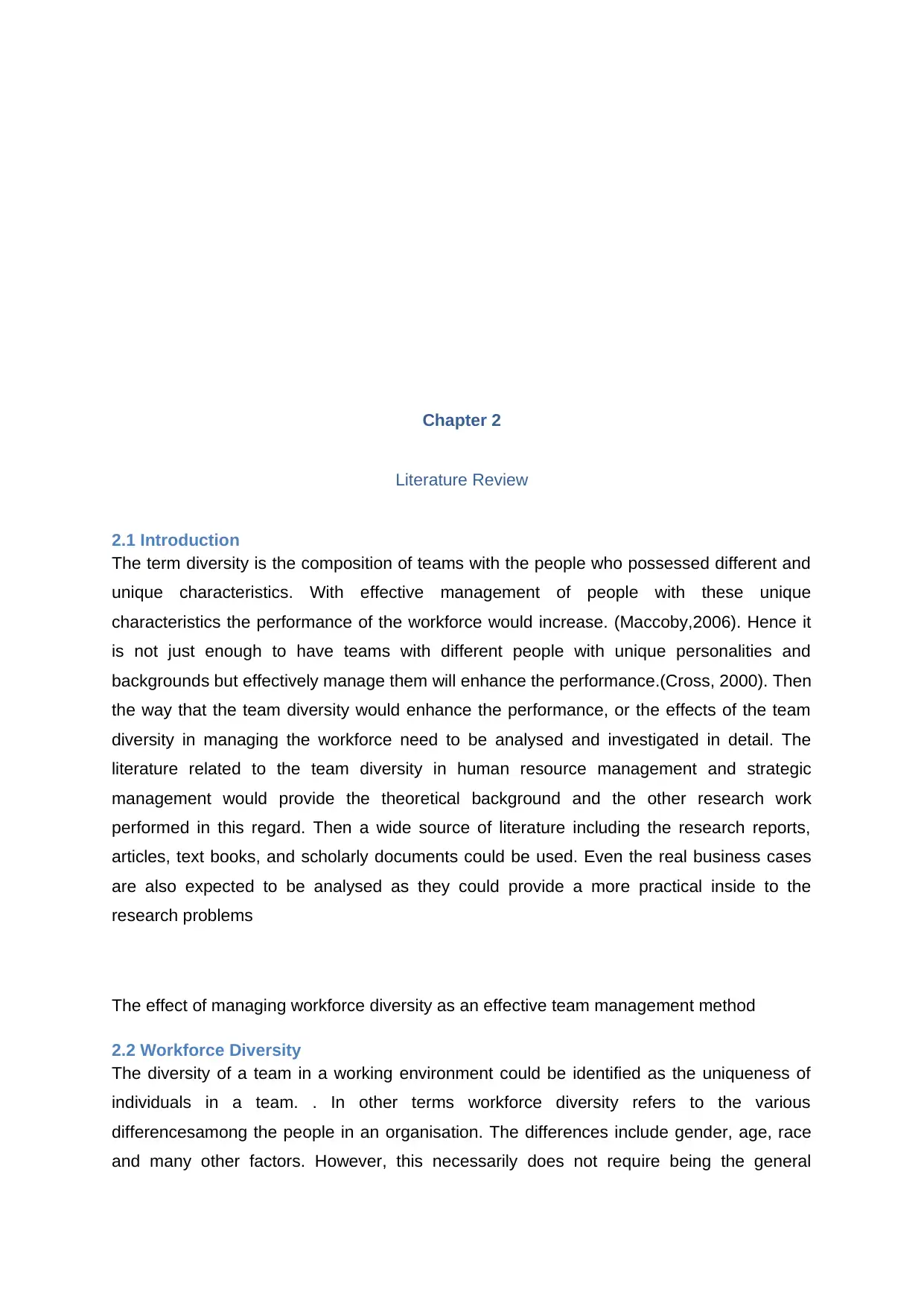
Chapter 2
Literature Review
2.1 Introduction
The term diversity is the composition of teams with the people who possessed different and
unique characteristics. With effective management of people with these unique
characteristics the performance of the workforce would increase. (Maccoby,2006). Hence it
is not just enough to have teams with different people with unique personalities and
backgrounds but effectively manage them will enhance the performance.(Cross, 2000). Then
the way that the team diversity would enhance the performance, or the effects of the team
diversity in managing the workforce need to be analysed and investigated in detail. The
literature related to the team diversity in human resource management and strategic
management would provide the theoretical background and the other research work
performed in this regard. Then a wide source of literature including the research reports,
articles, text books, and scholarly documents could be used. Even the real business cases
are also expected to be analysed as they could provide a more practical inside to the
research problems
The effect of managing workforce diversity as an effective team management method
2.2 Workforce Diversity
The diversity of a team in a working environment could be identified as the uniqueness of
individuals in a team. . In other terms workforce diversity refers to the various
differencesamong the people in an organisation. The differences include gender, age, race
and many other factors. However, this necessarily does not require being the general
Literature Review
2.1 Introduction
The term diversity is the composition of teams with the people who possessed different and
unique characteristics. With effective management of people with these unique
characteristics the performance of the workforce would increase. (Maccoby,2006). Hence it
is not just enough to have teams with different people with unique personalities and
backgrounds but effectively manage them will enhance the performance.(Cross, 2000). Then
the way that the team diversity would enhance the performance, or the effects of the team
diversity in managing the workforce need to be analysed and investigated in detail. The
literature related to the team diversity in human resource management and strategic
management would provide the theoretical background and the other research work
performed in this regard. Then a wide source of literature including the research reports,
articles, text books, and scholarly documents could be used. Even the real business cases
are also expected to be analysed as they could provide a more practical inside to the
research problems
The effect of managing workforce diversity as an effective team management method
2.2 Workforce Diversity
The diversity of a team in a working environment could be identified as the uniqueness of
individuals in a team. . In other terms workforce diversity refers to the various
differencesamong the people in an organisation. The differences include gender, age, race
and many other factors. However, this necessarily does not require being the general
Paraphrase This Document
Need a fresh take? Get an instant paraphrase of this document with our AI Paraphraser
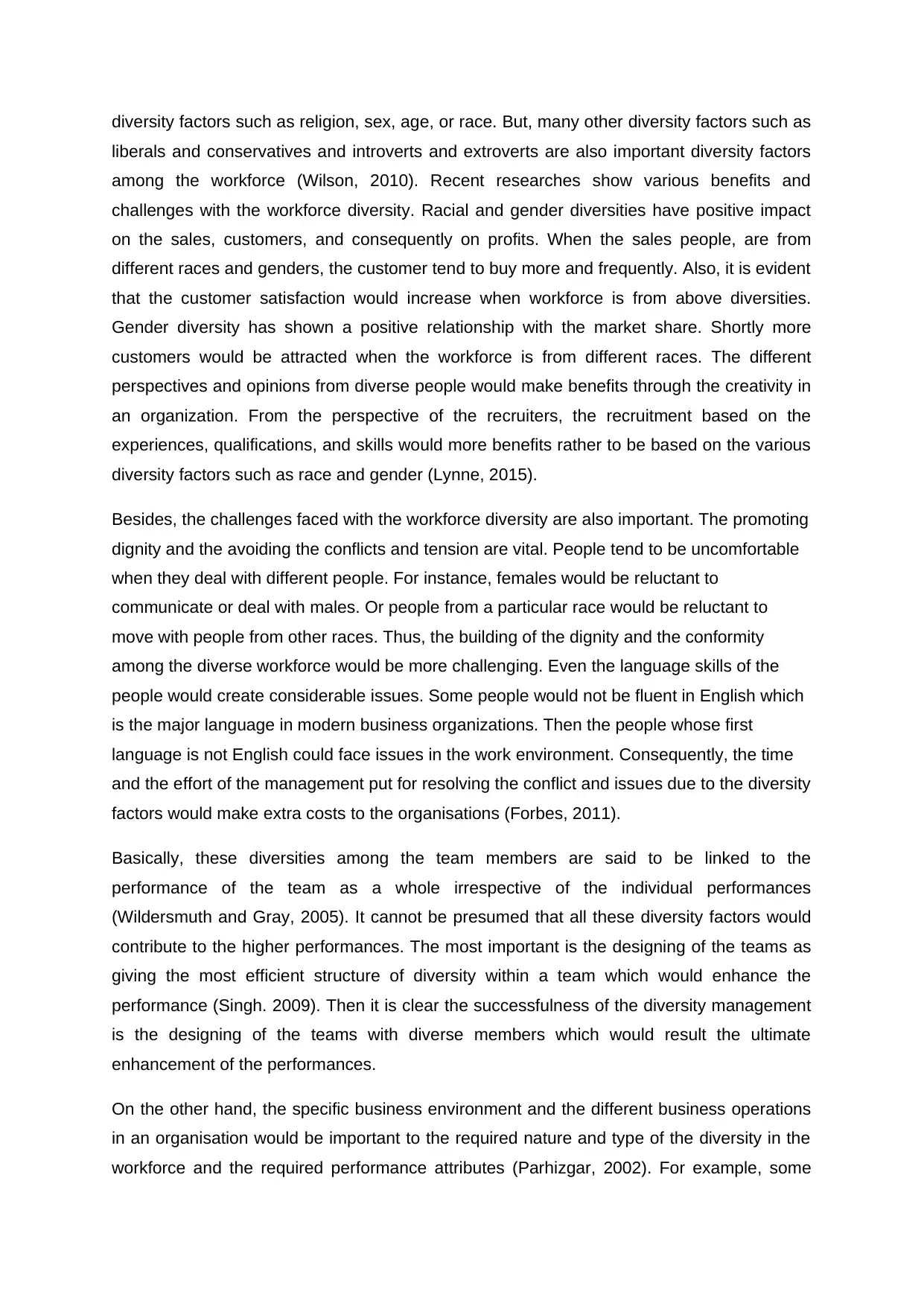
diversity factors such as religion, sex, age, or race. But, many other diversity factors such as
liberals and conservatives and introverts and extroverts are also important diversity factors
among the workforce (Wilson, 2010). Recent researches show various benefits and
challenges with the workforce diversity. Racial and gender diversities have positive impact
on the sales, customers, and consequently on profits. When the sales people, are from
different races and genders, the customer tend to buy more and frequently. Also, it is evident
that the customer satisfaction would increase when workforce is from above diversities.
Gender diversity has shown a positive relationship with the market share. Shortly more
customers would be attracted when the workforce is from different races. The different
perspectives and opinions from diverse people would make benefits through the creativity in
an organization. From the perspective of the recruiters, the recruitment based on the
experiences, qualifications, and skills would more benefits rather to be based on the various
diversity factors such as race and gender (Lynne, 2015).
Besides, the challenges faced with the workforce diversity are also important. The promoting
dignity and the avoiding the conflicts and tension are vital. People tend to be uncomfortable
when they deal with different people. For instance, females would be reluctant to
communicate or deal with males. Or people from a particular race would be reluctant to
move with people from other races. Thus, the building of the dignity and the conformity
among the diverse workforce would be more challenging. Even the language skills of the
people would create considerable issues. Some people would not be fluent in English which
is the major language in modern business organizations. Then the people whose first
language is not English could face issues in the work environment. Consequently, the time
and the effort of the management put for resolving the conflict and issues due to the diversity
factors would make extra costs to the organisations (Forbes, 2011).
Basically, these diversities among the team members are said to be linked to the
performance of the team as a whole irrespective of the individual performances
(Wildersmuth and Gray, 2005). It cannot be presumed that all these diversity factors would
contribute to the higher performances. The most important is the designing of the teams as
giving the most efficient structure of diversity within a team which would enhance the
performance (Singh. 2009). Then it is clear the successfulness of the diversity management
is the designing of the teams with diverse members which would result the ultimate
enhancement of the performances.
On the other hand, the specific business environment and the different business operations
in an organisation would be important to the required nature and type of the diversity in the
workforce and the required performance attributes (Parhizgar, 2002). For example, some
liberals and conservatives and introverts and extroverts are also important diversity factors
among the workforce (Wilson, 2010). Recent researches show various benefits and
challenges with the workforce diversity. Racial and gender diversities have positive impact
on the sales, customers, and consequently on profits. When the sales people, are from
different races and genders, the customer tend to buy more and frequently. Also, it is evident
that the customer satisfaction would increase when workforce is from above diversities.
Gender diversity has shown a positive relationship with the market share. Shortly more
customers would be attracted when the workforce is from different races. The different
perspectives and opinions from diverse people would make benefits through the creativity in
an organization. From the perspective of the recruiters, the recruitment based on the
experiences, qualifications, and skills would more benefits rather to be based on the various
diversity factors such as race and gender (Lynne, 2015).
Besides, the challenges faced with the workforce diversity are also important. The promoting
dignity and the avoiding the conflicts and tension are vital. People tend to be uncomfortable
when they deal with different people. For instance, females would be reluctant to
communicate or deal with males. Or people from a particular race would be reluctant to
move with people from other races. Thus, the building of the dignity and the conformity
among the diverse workforce would be more challenging. Even the language skills of the
people would create considerable issues. Some people would not be fluent in English which
is the major language in modern business organizations. Then the people whose first
language is not English could face issues in the work environment. Consequently, the time
and the effort of the management put for resolving the conflict and issues due to the diversity
factors would make extra costs to the organisations (Forbes, 2011).
Basically, these diversities among the team members are said to be linked to the
performance of the team as a whole irrespective of the individual performances
(Wildersmuth and Gray, 2005). It cannot be presumed that all these diversity factors would
contribute to the higher performances. The most important is the designing of the teams as
giving the most efficient structure of diversity within a team which would enhance the
performance (Singh. 2009). Then it is clear the successfulness of the diversity management
is the designing of the teams with diverse members which would result the ultimate
enhancement of the performances.
On the other hand, the specific business environment and the different business operations
in an organisation would be important to the required nature and type of the diversity in the
workforce and the required performance attributes (Parhizgar, 2002). For example, some
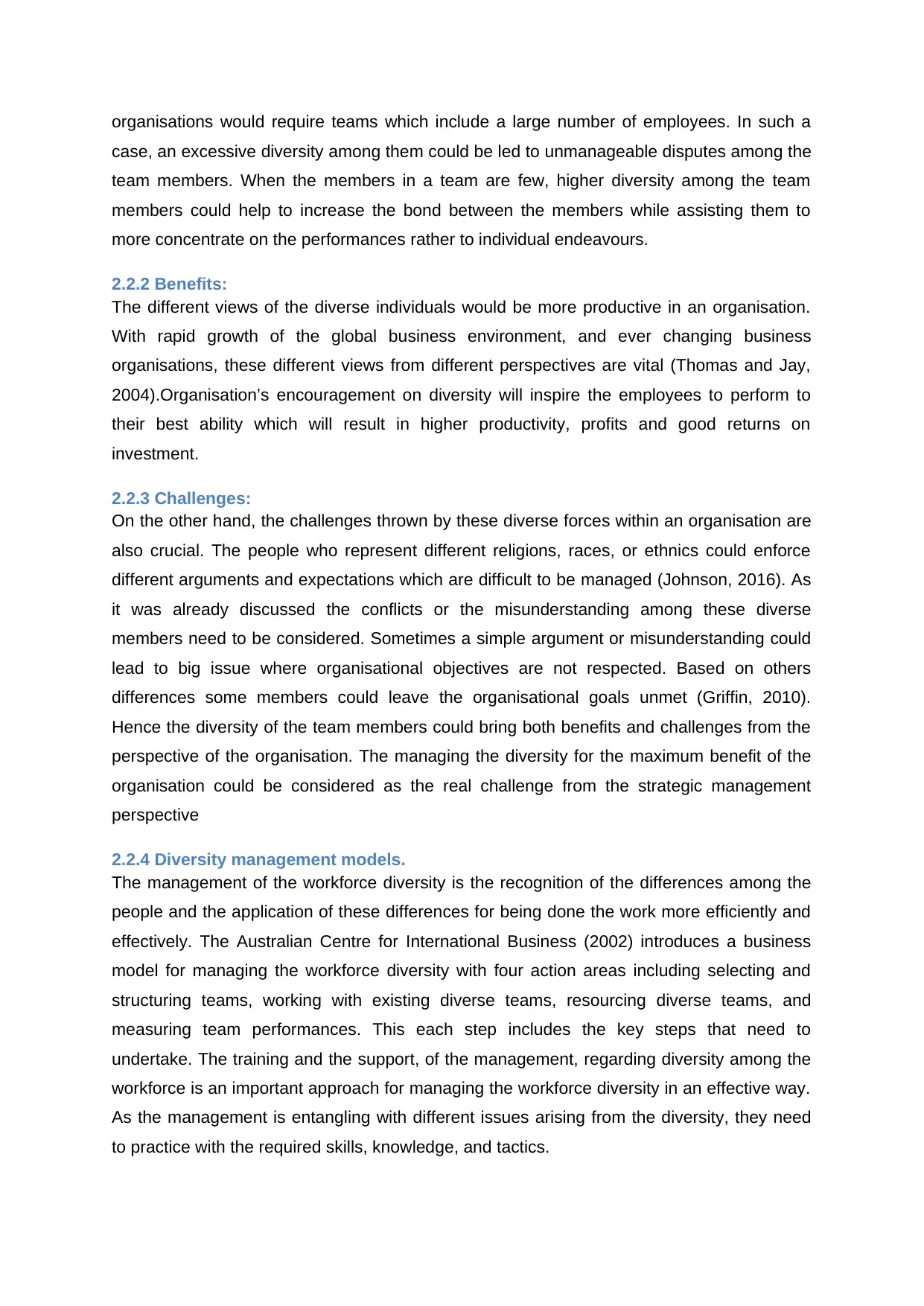
organisations would require teams which include a large number of employees. In such a
case, an excessive diversity among them could be led to unmanageable disputes among the
team members. When the members in a team are few, higher diversity among the team
members could help to increase the bond between the members while assisting them to
more concentrate on the performances rather to individual endeavours.
2.2.2 Benefits:
The different views of the diverse individuals would be more productive in an organisation.
With rapid growth of the global business environment, and ever changing business
organisations, these different views from different perspectives are vital (Thomas and Jay,
2004).Organisation’s encouragement on diversity will inspire the employees to perform to
their best ability which will result in higher productivity, profits and good returns on
investment.
2.2.3 Challenges:
On the other hand, the challenges thrown by these diverse forces within an organisation are
also crucial. The people who represent different religions, races, or ethnics could enforce
different arguments and expectations which are difficult to be managed (Johnson, 2016). As
it was already discussed the conflicts or the misunderstanding among these diverse
members need to be considered. Sometimes a simple argument or misunderstanding could
lead to big issue where organisational objectives are not respected. Based on others
differences some members could leave the organisational goals unmet (Griffin, 2010).
Hence the diversity of the team members could bring both benefits and challenges from the
perspective of the organisation. The managing the diversity for the maximum benefit of the
organisation could be considered as the real challenge from the strategic management
perspective
2.2.4 Diversity management models.
The management of the workforce diversity is the recognition of the differences among the
people and the application of these differences for being done the work more efficiently and
effectively. The Australian Centre for International Business (2002) introduces a business
model for managing the workforce diversity with four action areas including selecting and
structuring teams, working with existing diverse teams, resourcing diverse teams, and
measuring team performances. This each step includes the key steps that need to
undertake. The training and the support, of the management, regarding diversity among the
workforce is an important approach for managing the workforce diversity in an effective way.
As the management is entangling with different issues arising from the diversity, they need
to practice with the required skills, knowledge, and tactics.
case, an excessive diversity among them could be led to unmanageable disputes among the
team members. When the members in a team are few, higher diversity among the team
members could help to increase the bond between the members while assisting them to
more concentrate on the performances rather to individual endeavours.
2.2.2 Benefits:
The different views of the diverse individuals would be more productive in an organisation.
With rapid growth of the global business environment, and ever changing business
organisations, these different views from different perspectives are vital (Thomas and Jay,
2004).Organisation’s encouragement on diversity will inspire the employees to perform to
their best ability which will result in higher productivity, profits and good returns on
investment.
2.2.3 Challenges:
On the other hand, the challenges thrown by these diverse forces within an organisation are
also crucial. The people who represent different religions, races, or ethnics could enforce
different arguments and expectations which are difficult to be managed (Johnson, 2016). As
it was already discussed the conflicts or the misunderstanding among these diverse
members need to be considered. Sometimes a simple argument or misunderstanding could
lead to big issue where organisational objectives are not respected. Based on others
differences some members could leave the organisational goals unmet (Griffin, 2010).
Hence the diversity of the team members could bring both benefits and challenges from the
perspective of the organisation. The managing the diversity for the maximum benefit of the
organisation could be considered as the real challenge from the strategic management
perspective
2.2.4 Diversity management models.
The management of the workforce diversity is the recognition of the differences among the
people and the application of these differences for being done the work more efficiently and
effectively. The Australian Centre for International Business (2002) introduces a business
model for managing the workforce diversity with four action areas including selecting and
structuring teams, working with existing diverse teams, resourcing diverse teams, and
measuring team performances. This each step includes the key steps that need to
undertake. The training and the support, of the management, regarding diversity among the
workforce is an important approach for managing the workforce diversity in an effective way.
As the management is entangling with different issues arising from the diversity, they need
to practice with the required skills, knowledge, and tactics.
⊘ This is a preview!⊘
Do you want full access?
Subscribe today to unlock all pages.

Trusted by 1+ million students worldwide
1 out of 47
Related Documents
Your All-in-One AI-Powered Toolkit for Academic Success.
+13062052269
info@desklib.com
Available 24*7 on WhatsApp / Email
![[object Object]](/_next/static/media/star-bottom.7253800d.svg)
Unlock your academic potential
Copyright © 2020–2025 A2Z Services. All Rights Reserved. Developed and managed by ZUCOL.




